Newborn Screening: Diagnosis of Inherited Metabolic Disorders Report
VerifiedAdded on 2022/12/29
|12
|2313
|67
Report
AI Summary
This report provides a detailed overview of the diagnosis of Inherited Metabolic Disorders (IMD) through newborn screening programs. It discusses the methods, including the use of dried blood spot (DBS) techniques and tandem mass spectrometry (MS), highlighting their significance in early detection of genetic and metabolic disorders. The report delves into the pre-analytical and analytical factors influencing the screening process, such as data collection devices, sample stability, and assay calibration. It presents the results of MS-based analysis, focusing on the detection of amino acids, acylcarnitines, and fatty acid oxidation disorders, with specific attention to conditions like PKU and MCAD. Furthermore, the report explores the clinical implications of the findings, recommendations, and the evolution of newborn screening practices, emphasizing the importance of early diagnosis and treatment for improved patient outcomes. The discussion section covers the historical context of newborn screening, technological advancements, and the global impact of these programs, underscoring their role in preventing severe health issues and improving public health outcomes.
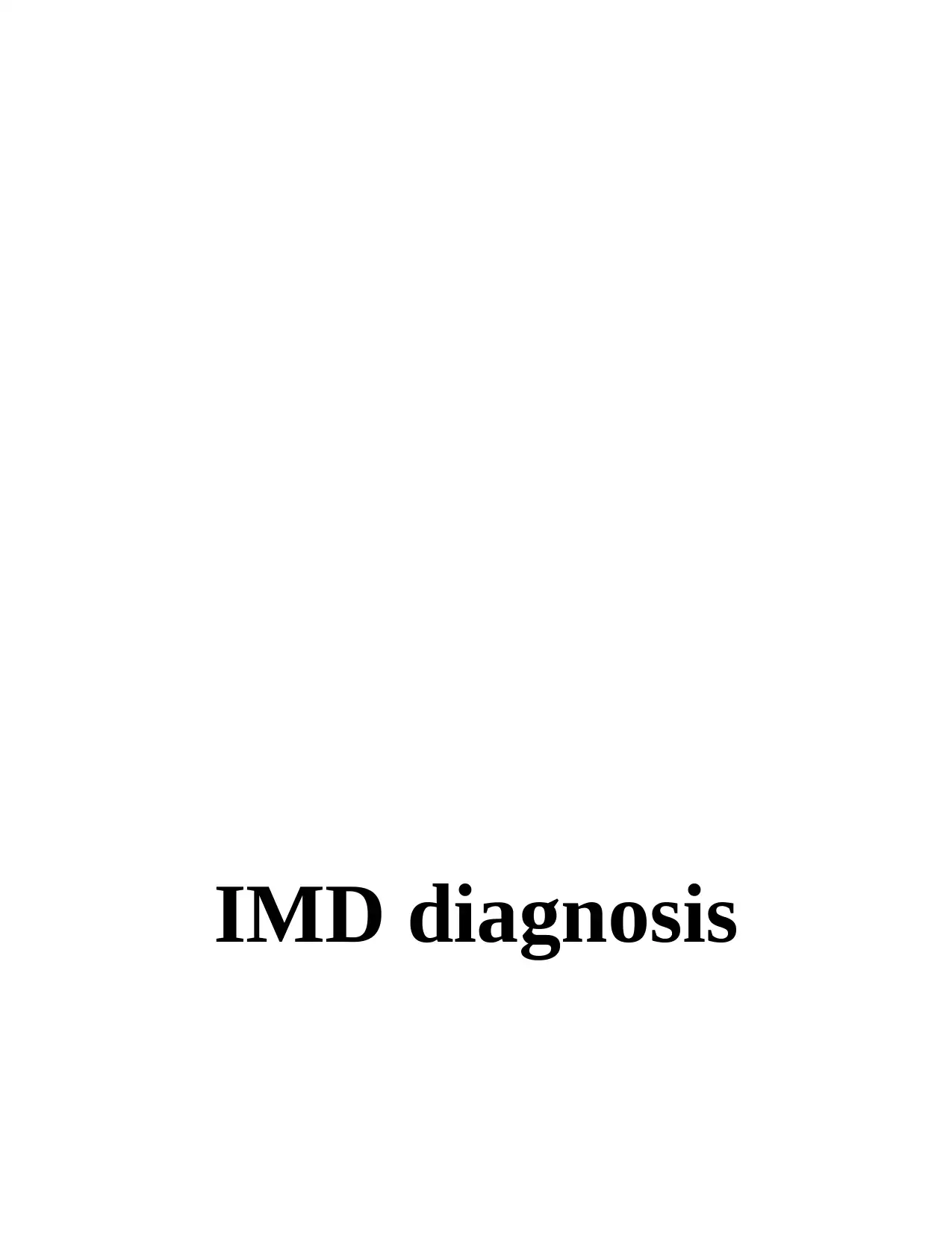
IMD diagnosis
Paraphrase This Document
Need a fresh take? Get an instant paraphrase of this document with our AI Paraphraser
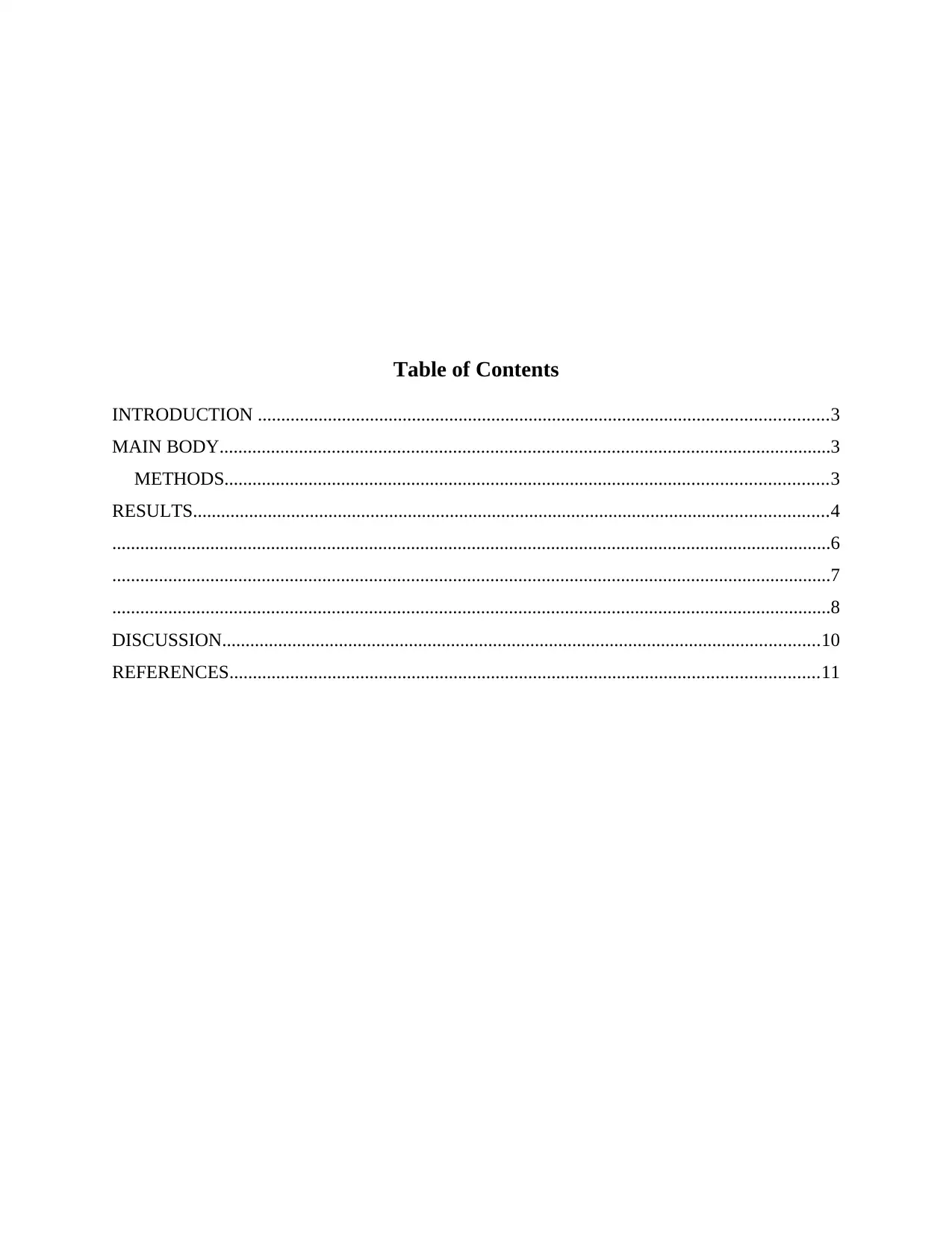
Table of Contents
INTRODUCTION ..........................................................................................................................3
MAIN BODY...................................................................................................................................3
METHODS.................................................................................................................................3
RESULTS........................................................................................................................................4
..........................................................................................................................................................6
..........................................................................................................................................................7
..........................................................................................................................................................8
DISCUSSION................................................................................................................................10
REFERENCES..............................................................................................................................11
INTRODUCTION ..........................................................................................................................3
MAIN BODY...................................................................................................................................3
METHODS.................................................................................................................................3
RESULTS........................................................................................................................................4
..........................................................................................................................................................6
..........................................................................................................................................................7
..........................................................................................................................................................8
DISCUSSION................................................................................................................................10
REFERENCES..............................................................................................................................11
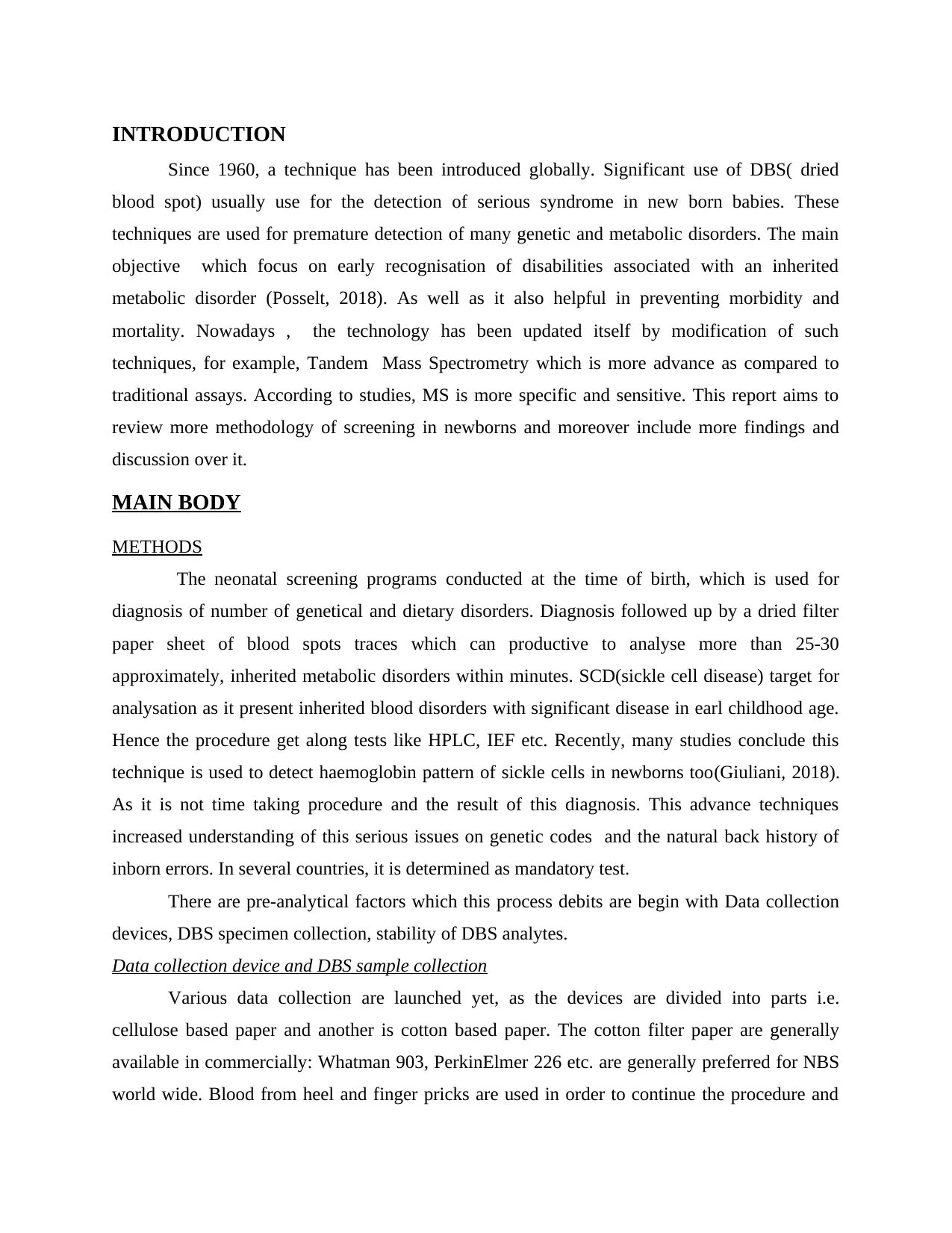
INTRODUCTION
Since 1960, a technique has been introduced globally. Significant use of DBS( dried
blood spot) usually use for the detection of serious syndrome in new born babies. These
techniques are used for premature detection of many genetic and metabolic disorders. The main
objective which focus on early recognisation of disabilities associated with an inherited
metabolic disorder (Posselt, 2018). As well as it also helpful in preventing morbidity and
mortality. Nowadays , the technology has been updated itself by modification of such
techniques, for example, Tandem Mass Spectrometry which is more advance as compared to
traditional assays. According to studies, MS is more specific and sensitive. This report aims to
review more methodology of screening in newborns and moreover include more findings and
discussion over it.
MAIN BODY
METHODS
The neonatal screening programs conducted at the time of birth, which is used for
diagnosis of number of genetical and dietary disorders. Diagnosis followed up by a dried filter
paper sheet of blood spots traces which can productive to analyse more than 25-30
approximately, inherited metabolic disorders within minutes. SCD(sickle cell disease) target for
analysation as it present inherited blood disorders with significant disease in earl childhood age.
Hence the procedure get along tests like HPLC, IEF etc. Recently, many studies conclude this
technique is used to detect haemoglobin pattern of sickle cells in newborns too(Giuliani, 2018).
As it is not time taking procedure and the result of this diagnosis. This advance techniques
increased understanding of this serious issues on genetic codes and the natural back history of
inborn errors. In several countries, it is determined as mandatory test.
There are pre-analytical factors which this process debits are begin with Data collection
devices, DBS specimen collection, stability of DBS analytes.
Data collection device and DBS sample collection
Various data collection are launched yet, as the devices are divided into parts i.e.
cellulose based paper and another is cotton based paper. The cotton filter paper are generally
available in commercially: Whatman 903, PerkinElmer 226 etc. are generally preferred for NBS
world wide. Blood from heel and finger pricks are used in order to continue the procedure and
Since 1960, a technique has been introduced globally. Significant use of DBS( dried
blood spot) usually use for the detection of serious syndrome in new born babies. These
techniques are used for premature detection of many genetic and metabolic disorders. The main
objective which focus on early recognisation of disabilities associated with an inherited
metabolic disorder (Posselt, 2018). As well as it also helpful in preventing morbidity and
mortality. Nowadays , the technology has been updated itself by modification of such
techniques, for example, Tandem Mass Spectrometry which is more advance as compared to
traditional assays. According to studies, MS is more specific and sensitive. This report aims to
review more methodology of screening in newborns and moreover include more findings and
discussion over it.
MAIN BODY
METHODS
The neonatal screening programs conducted at the time of birth, which is used for
diagnosis of number of genetical and dietary disorders. Diagnosis followed up by a dried filter
paper sheet of blood spots traces which can productive to analyse more than 25-30
approximately, inherited metabolic disorders within minutes. SCD(sickle cell disease) target for
analysation as it present inherited blood disorders with significant disease in earl childhood age.
Hence the procedure get along tests like HPLC, IEF etc. Recently, many studies conclude this
technique is used to detect haemoglobin pattern of sickle cells in newborns too(Giuliani, 2018).
As it is not time taking procedure and the result of this diagnosis. This advance techniques
increased understanding of this serious issues on genetic codes and the natural back history of
inborn errors. In several countries, it is determined as mandatory test.
There are pre-analytical factors which this process debits are begin with Data collection
devices, DBS specimen collection, stability of DBS analytes.
Data collection device and DBS sample collection
Various data collection are launched yet, as the devices are divided into parts i.e.
cellulose based paper and another is cotton based paper. The cotton filter paper are generally
available in commercially: Whatman 903, PerkinElmer 226 etc. are generally preferred for NBS
world wide. Blood from heel and finger pricks are used in order to continue the procedure and
⊘ This is a preview!⊘
Do you want full access?
Subscribe today to unlock all pages.

Trusted by 1+ million students worldwide
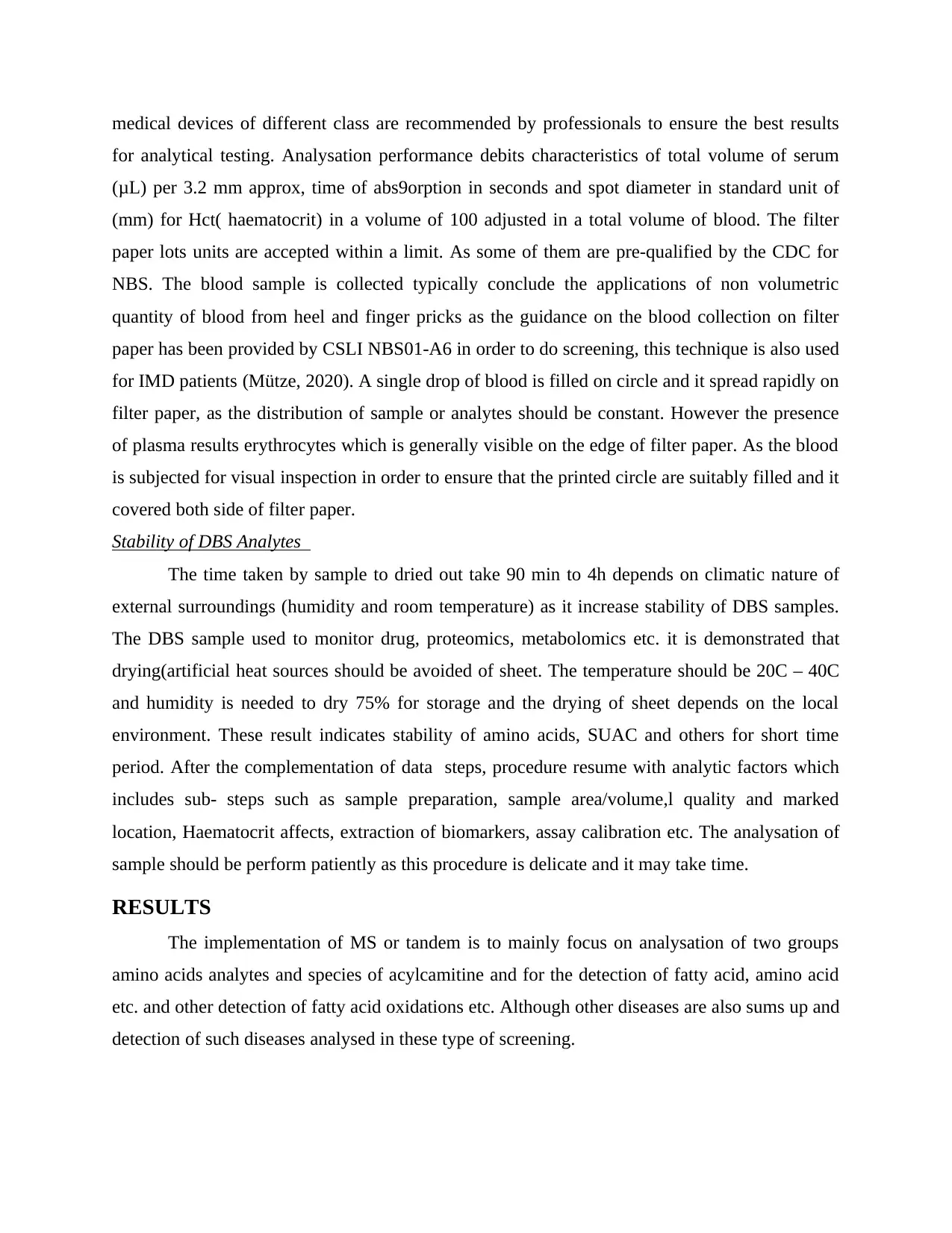
medical devices of different class are recommended by professionals to ensure the best results
for analytical testing. Analysation performance debits characteristics of total volume of serum
(μL) per 3.2 mm approx, time of abs9orption in seconds and spot diameter in standard unit of
(mm) for Hct( haematocrit) in a volume of 100 adjusted in a total volume of blood. The filter
paper lots units are accepted within a limit. As some of them are pre-qualified by the CDC for
NBS. The blood sample is collected typically conclude the applications of non volumetric
quantity of blood from heel and finger pricks as the guidance on the blood collection on filter
paper has been provided by CSLI NBS01-A6 in order to do screening, this technique is also used
for IMD patients (Mütze, 2020). A single drop of blood is filled on circle and it spread rapidly on
filter paper, as the distribution of sample or analytes should be constant. However the presence
of plasma results erythrocytes which is generally visible on the edge of filter paper. As the blood
is subjected for visual inspection in order to ensure that the printed circle are suitably filled and it
covered both side of filter paper.
Stability of DBS Analytes
The time taken by sample to dried out take 90 min to 4h depends on climatic nature of
external surroundings (humidity and room temperature) as it increase stability of DBS samples.
The DBS sample used to monitor drug, proteomics, metabolomics etc. it is demonstrated that
drying(artificial heat sources should be avoided of sheet. The temperature should be 20C – 40C
and humidity is needed to dry 75% for storage and the drying of sheet depends on the local
environment. These result indicates stability of amino acids, SUAC and others for short time
period. After the complementation of data steps, procedure resume with analytic factors which
includes sub- steps such as sample preparation, sample area/volume,l quality and marked
location, Haematocrit affects, extraction of biomarkers, assay calibration etc. The analysation of
sample should be perform patiently as this procedure is delicate and it may take time.
RESULTS
The implementation of MS or tandem is to mainly focus on analysation of two groups
amino acids analytes and species of acylcamitine and for the detection of fatty acid, amino acid
etc. and other detection of fatty acid oxidations etc. Although other diseases are also sums up and
detection of such diseases analysed in these type of screening.
for analytical testing. Analysation performance debits characteristics of total volume of serum
(μL) per 3.2 mm approx, time of abs9orption in seconds and spot diameter in standard unit of
(mm) for Hct( haematocrit) in a volume of 100 adjusted in a total volume of blood. The filter
paper lots units are accepted within a limit. As some of them are pre-qualified by the CDC for
NBS. The blood sample is collected typically conclude the applications of non volumetric
quantity of blood from heel and finger pricks as the guidance on the blood collection on filter
paper has been provided by CSLI NBS01-A6 in order to do screening, this technique is also used
for IMD patients (Mütze, 2020). A single drop of blood is filled on circle and it spread rapidly on
filter paper, as the distribution of sample or analytes should be constant. However the presence
of plasma results erythrocytes which is generally visible on the edge of filter paper. As the blood
is subjected for visual inspection in order to ensure that the printed circle are suitably filled and it
covered both side of filter paper.
Stability of DBS Analytes
The time taken by sample to dried out take 90 min to 4h depends on climatic nature of
external surroundings (humidity and room temperature) as it increase stability of DBS samples.
The DBS sample used to monitor drug, proteomics, metabolomics etc. it is demonstrated that
drying(artificial heat sources should be avoided of sheet. The temperature should be 20C – 40C
and humidity is needed to dry 75% for storage and the drying of sheet depends on the local
environment. These result indicates stability of amino acids, SUAC and others for short time
period. After the complementation of data steps, procedure resume with analytic factors which
includes sub- steps such as sample preparation, sample area/volume,l quality and marked
location, Haematocrit affects, extraction of biomarkers, assay calibration etc. The analysation of
sample should be perform patiently as this procedure is delicate and it may take time.
RESULTS
The implementation of MS or tandem is to mainly focus on analysation of two groups
amino acids analytes and species of acylcamitine and for the detection of fatty acid, amino acid
etc. and other detection of fatty acid oxidations etc. Although other diseases are also sums up and
detection of such diseases analysed in these type of screening.
Paraphrase This Document
Need a fresh take? Get an instant paraphrase of this document with our AI Paraphraser

As screening on new born babies are based on criteria, that criteria are as follows,
(1)characteristic of clinical perhaps it can happen by incidence, it is demonstrated as burden of
these infections if in case not treated as well as phenotype in infants (2) analytical properties
(3)treatment, diagnosis including management, each disorder debits it score. Conditions of
disease conclude greater than 1200 the criteria. In the section of diagnosis all deficiency of
MCAD as well as PKU briefly described. PKU is considered as common disorder and it can
easily detected. According to studies PKU is autosomal disorder and it is caused by mutated
genes codes. it is detected immediately at the time of birth, it helps in preventing mental
retardation which is irreversible in condition. As upper chart shows the disorders in infants
which is in mild conditions. Recommendations on the ACMG, approximately 29 core can be
detected in this following technique.
(1)characteristic of clinical perhaps it can happen by incidence, it is demonstrated as burden of
these infections if in case not treated as well as phenotype in infants (2) analytical properties
(3)treatment, diagnosis including management, each disorder debits it score. Conditions of
disease conclude greater than 1200 the criteria. In the section of diagnosis all deficiency of
MCAD as well as PKU briefly described. PKU is considered as common disorder and it can
easily detected. According to studies PKU is autosomal disorder and it is caused by mutated
genes codes. it is detected immediately at the time of birth, it helps in preventing mental
retardation which is irreversible in condition. As upper chart shows the disorders in infants
which is in mild conditions. Recommendations on the ACMG, approximately 29 core can be
detected in this following technique.
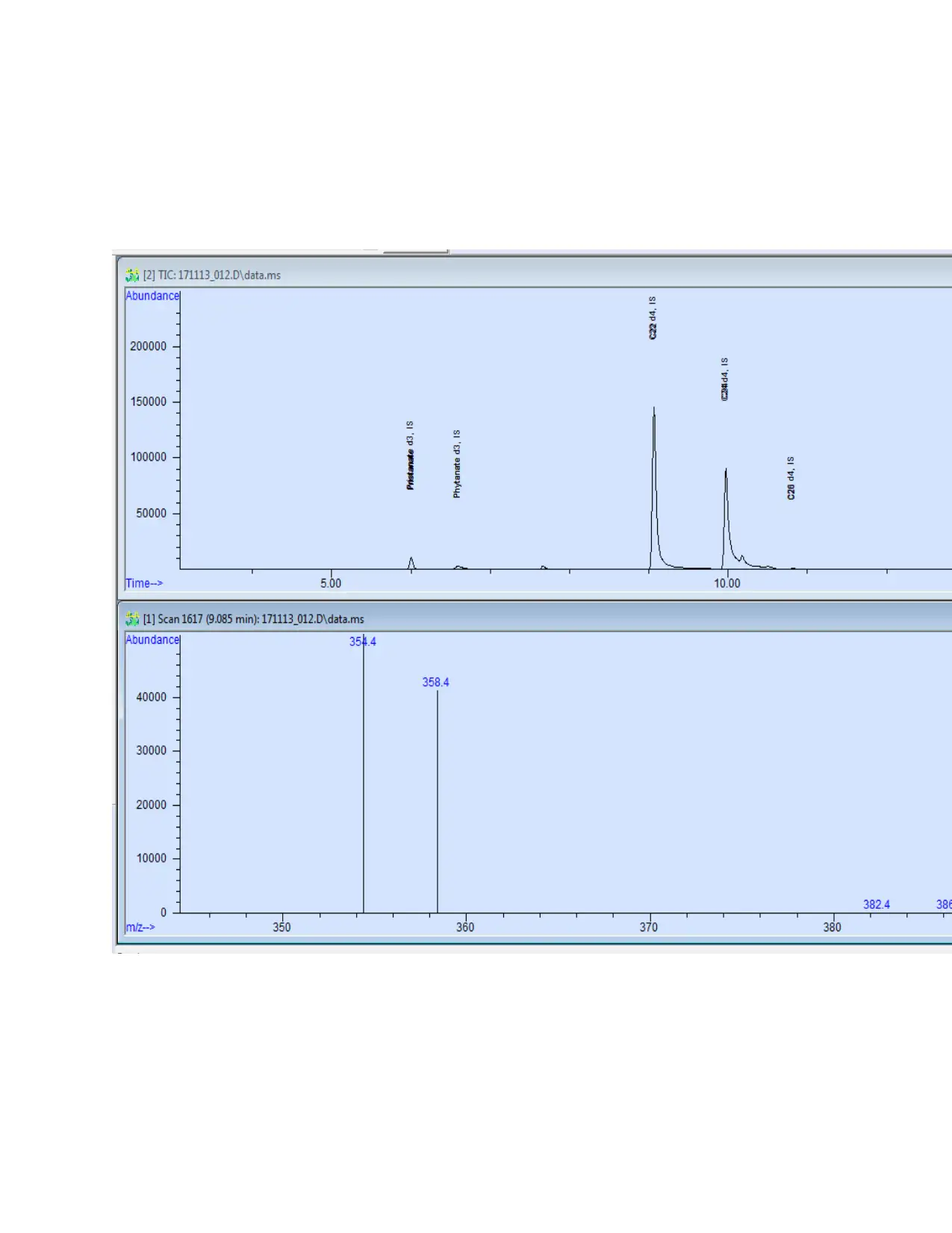
⊘ This is a preview!⊘
Do you want full access?
Subscribe today to unlock all pages.

Trusted by 1+ million students worldwide
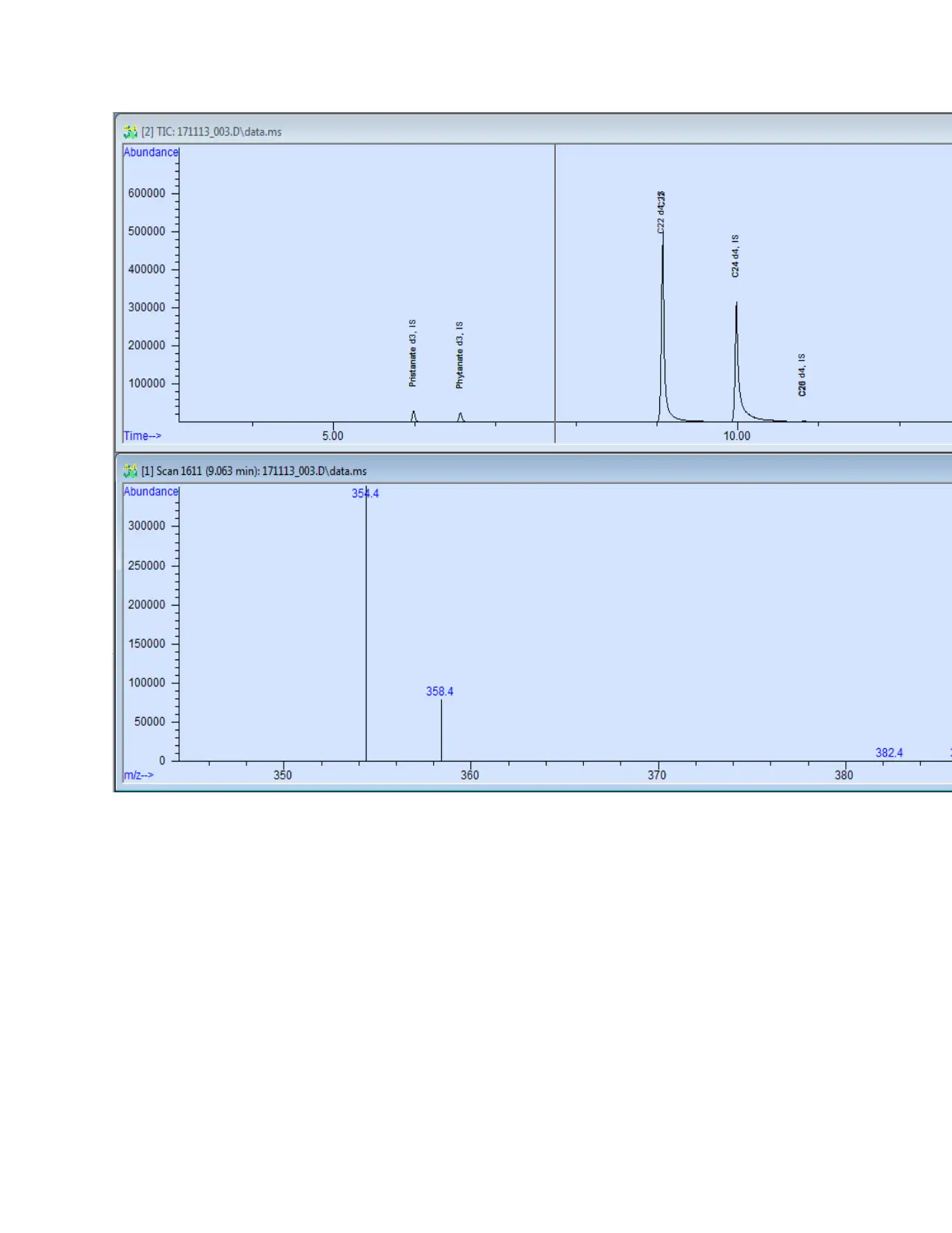
Paraphrase This Document
Need a fresh take? Get an instant paraphrase of this document with our AI Paraphraser
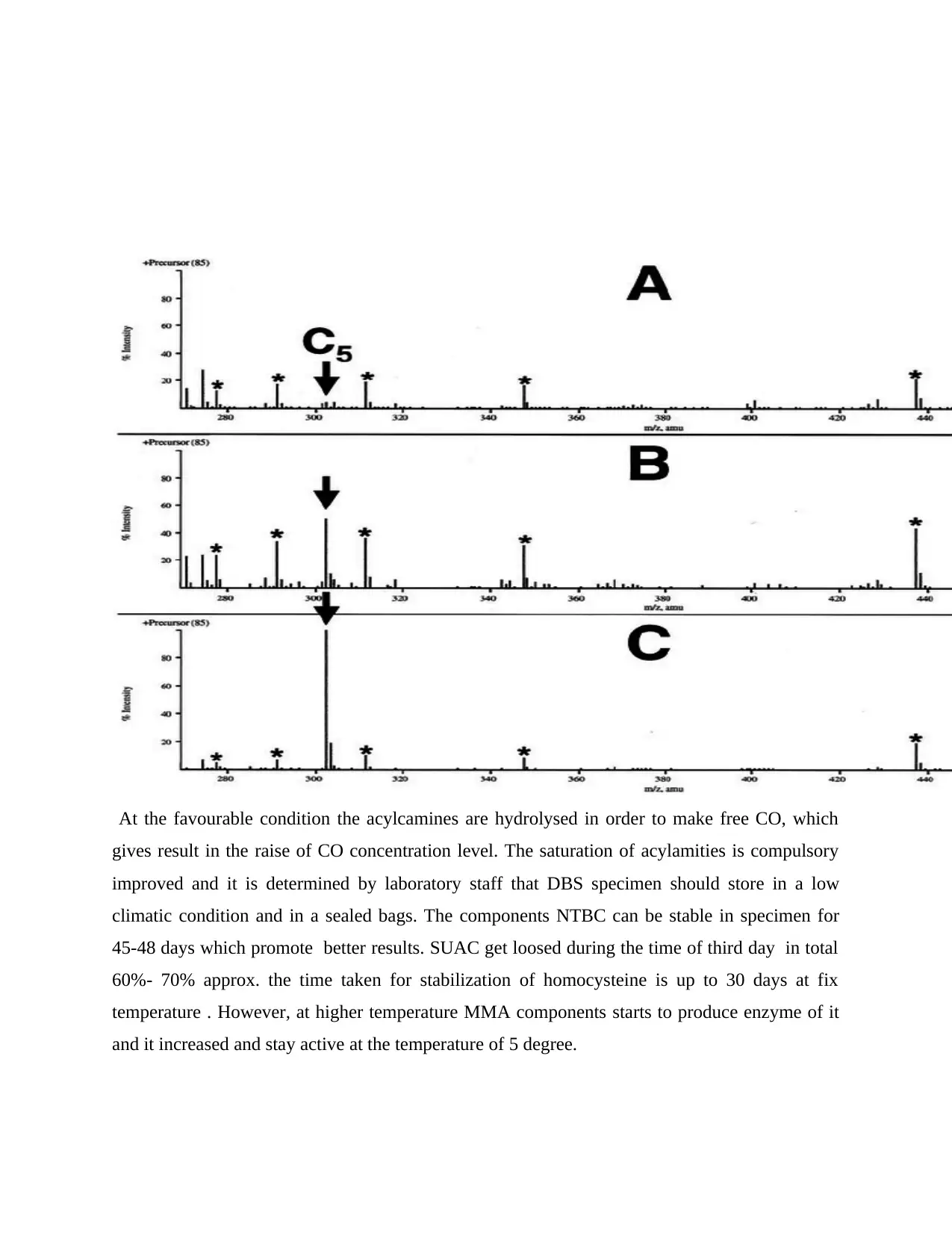
At the favourable condition the acylcamines are hydrolysed in order to make free CO, which
gives result in the raise of CO concentration level. The saturation of acylamities is compulsory
improved and it is determined by laboratory staff that DBS specimen should store in a low
climatic condition and in a sealed bags. The components NTBC can be stable in specimen for
45-48 days which promote better results. SUAC get loosed during the time of third day in total
60%- 70% approx. the time taken for stabilization of homocysteine is up to 30 days at fix
temperature . However, at higher temperature MMA components starts to produce enzyme of it
and it increased and stay active at the temperature of 5 degree.
gives result in the raise of CO concentration level. The saturation of acylamities is compulsory
improved and it is determined by laboratory staff that DBS specimen should store in a low
climatic condition and in a sealed bags. The components NTBC can be stable in specimen for
45-48 days which promote better results. SUAC get loosed during the time of third day in total
60%- 70% approx. the time taken for stabilization of homocysteine is up to 30 days at fix
temperature . However, at higher temperature MMA components starts to produce enzyme of it
and it increased and stay active at the temperature of 5 degree.
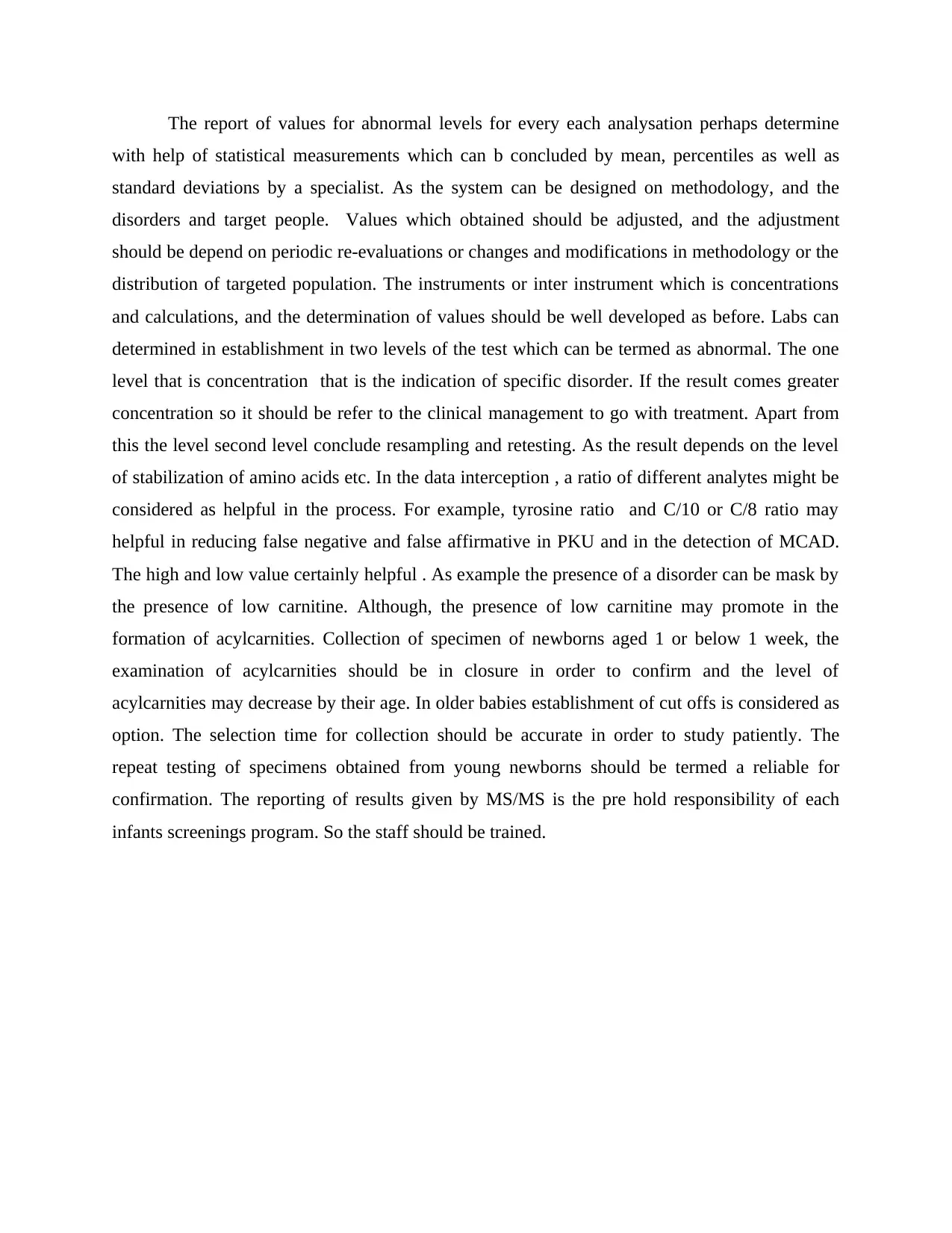
The report of values for abnormal levels for every each analysation perhaps determine
with help of statistical measurements which can b concluded by mean, percentiles as well as
standard deviations by a specialist. As the system can be designed on methodology, and the
disorders and target people. Values which obtained should be adjusted, and the adjustment
should be depend on periodic re-evaluations or changes and modifications in methodology or the
distribution of targeted population. The instruments or inter instrument which is concentrations
and calculations, and the determination of values should be well developed as before. Labs can
determined in establishment in two levels of the test which can be termed as abnormal. The one
level that is concentration that is the indication of specific disorder. If the result comes greater
concentration so it should be refer to the clinical management to go with treatment. Apart from
this the level second level conclude resampling and retesting. As the result depends on the level
of stabilization of amino acids etc. In the data interception , a ratio of different analytes might be
considered as helpful in the process. For example, tyrosine ratio and C/10 or C/8 ratio may
helpful in reducing false negative and false affirmative in PKU and in the detection of MCAD.
The high and low value certainly helpful . As example the presence of a disorder can be mask by
the presence of low carnitine. Although, the presence of low carnitine may promote in the
formation of acylcarnities. Collection of specimen of newborns aged 1 or below 1 week, the
examination of acylcarnities should be in closure in order to confirm and the level of
acylcarnities may decrease by their age. In older babies establishment of cut offs is considered as
option. The selection time for collection should be accurate in order to study patiently. The
repeat testing of specimens obtained from young newborns should be termed a reliable for
confirmation. The reporting of results given by MS/MS is the pre hold responsibility of each
infants screenings program. So the staff should be trained.
with help of statistical measurements which can b concluded by mean, percentiles as well as
standard deviations by a specialist. As the system can be designed on methodology, and the
disorders and target people. Values which obtained should be adjusted, and the adjustment
should be depend on periodic re-evaluations or changes and modifications in methodology or the
distribution of targeted population. The instruments or inter instrument which is concentrations
and calculations, and the determination of values should be well developed as before. Labs can
determined in establishment in two levels of the test which can be termed as abnormal. The one
level that is concentration that is the indication of specific disorder. If the result comes greater
concentration so it should be refer to the clinical management to go with treatment. Apart from
this the level second level conclude resampling and retesting. As the result depends on the level
of stabilization of amino acids etc. In the data interception , a ratio of different analytes might be
considered as helpful in the process. For example, tyrosine ratio and C/10 or C/8 ratio may
helpful in reducing false negative and false affirmative in PKU and in the detection of MCAD.
The high and low value certainly helpful . As example the presence of a disorder can be mask by
the presence of low carnitine. Although, the presence of low carnitine may promote in the
formation of acylcarnities. Collection of specimen of newborns aged 1 or below 1 week, the
examination of acylcarnities should be in closure in order to confirm and the level of
acylcarnities may decrease by their age. In older babies establishment of cut offs is considered as
option. The selection time for collection should be accurate in order to study patiently. The
repeat testing of specimens obtained from young newborns should be termed a reliable for
confirmation. The reporting of results given by MS/MS is the pre hold responsibility of each
infants screenings program. So the staff should be trained.
⊘ This is a preview!⊘
Do you want full access?
Subscribe today to unlock all pages.

Trusted by 1+ million students worldwide
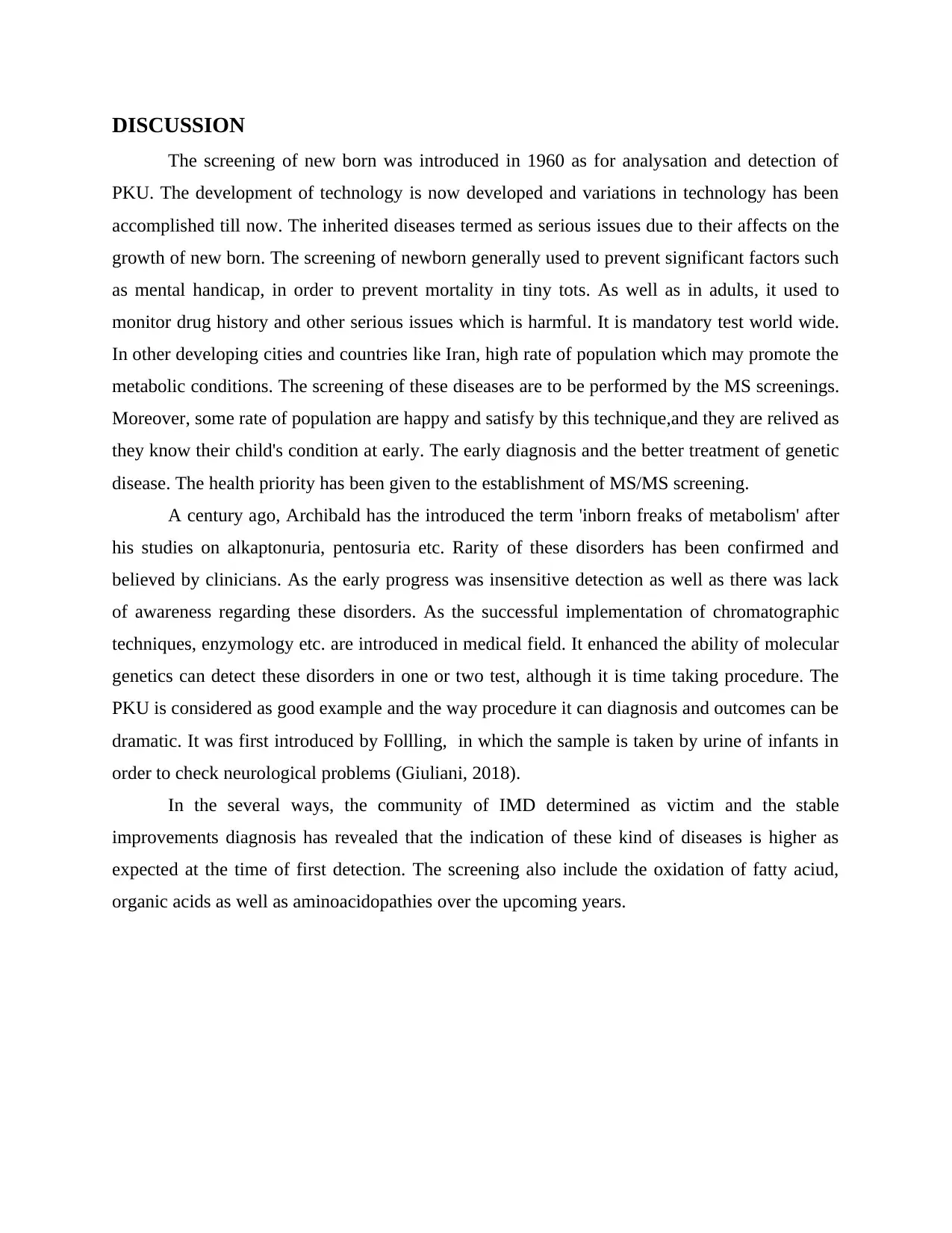
DISCUSSION
The screening of new born was introduced in 1960 as for analysation and detection of
PKU. The development of technology is now developed and variations in technology has been
accomplished till now. The inherited diseases termed as serious issues due to their affects on the
growth of new born. The screening of newborn generally used to prevent significant factors such
as mental handicap, in order to prevent mortality in tiny tots. As well as in adults, it used to
monitor drug history and other serious issues which is harmful. It is mandatory test world wide.
In other developing cities and countries like Iran, high rate of population which may promote the
metabolic conditions. The screening of these diseases are to be performed by the MS screenings.
Moreover, some rate of population are happy and satisfy by this technique,and they are relived as
they know their child's condition at early. The early diagnosis and the better treatment of genetic
disease. The health priority has been given to the establishment of MS/MS screening.
A century ago, Archibald has the introduced the term 'inborn freaks of metabolism' after
his studies on alkaptonuria, pentosuria etc. Rarity of these disorders has been confirmed and
believed by clinicians. As the early progress was insensitive detection as well as there was lack
of awareness regarding these disorders. As the successful implementation of chromatographic
techniques, enzymology etc. are introduced in medical field. It enhanced the ability of molecular
genetics can detect these disorders in one or two test, although it is time taking procedure. The
PKU is considered as good example and the way procedure it can diagnosis and outcomes can be
dramatic. It was first introduced by Follling, in which the sample is taken by urine of infants in
order to check neurological problems (Giuliani, 2018).
In the several ways, the community of IMD determined as victim and the stable
improvements diagnosis has revealed that the indication of these kind of diseases is higher as
expected at the time of first detection. The screening also include the oxidation of fatty aciud,
organic acids as well as aminoacidopathies over the upcoming years.
The screening of new born was introduced in 1960 as for analysation and detection of
PKU. The development of technology is now developed and variations in technology has been
accomplished till now. The inherited diseases termed as serious issues due to their affects on the
growth of new born. The screening of newborn generally used to prevent significant factors such
as mental handicap, in order to prevent mortality in tiny tots. As well as in adults, it used to
monitor drug history and other serious issues which is harmful. It is mandatory test world wide.
In other developing cities and countries like Iran, high rate of population which may promote the
metabolic conditions. The screening of these diseases are to be performed by the MS screenings.
Moreover, some rate of population are happy and satisfy by this technique,and they are relived as
they know their child's condition at early. The early diagnosis and the better treatment of genetic
disease. The health priority has been given to the establishment of MS/MS screening.
A century ago, Archibald has the introduced the term 'inborn freaks of metabolism' after
his studies on alkaptonuria, pentosuria etc. Rarity of these disorders has been confirmed and
believed by clinicians. As the early progress was insensitive detection as well as there was lack
of awareness regarding these disorders. As the successful implementation of chromatographic
techniques, enzymology etc. are introduced in medical field. It enhanced the ability of molecular
genetics can detect these disorders in one or two test, although it is time taking procedure. The
PKU is considered as good example and the way procedure it can diagnosis and outcomes can be
dramatic. It was first introduced by Follling, in which the sample is taken by urine of infants in
order to check neurological problems (Giuliani, 2018).
In the several ways, the community of IMD determined as victim and the stable
improvements diagnosis has revealed that the indication of these kind of diseases is higher as
expected at the time of first detection. The screening also include the oxidation of fatty aciud,
organic acids as well as aminoacidopathies over the upcoming years.
Paraphrase This Document
Need a fresh take? Get an instant paraphrase of this document with our AI Paraphraser
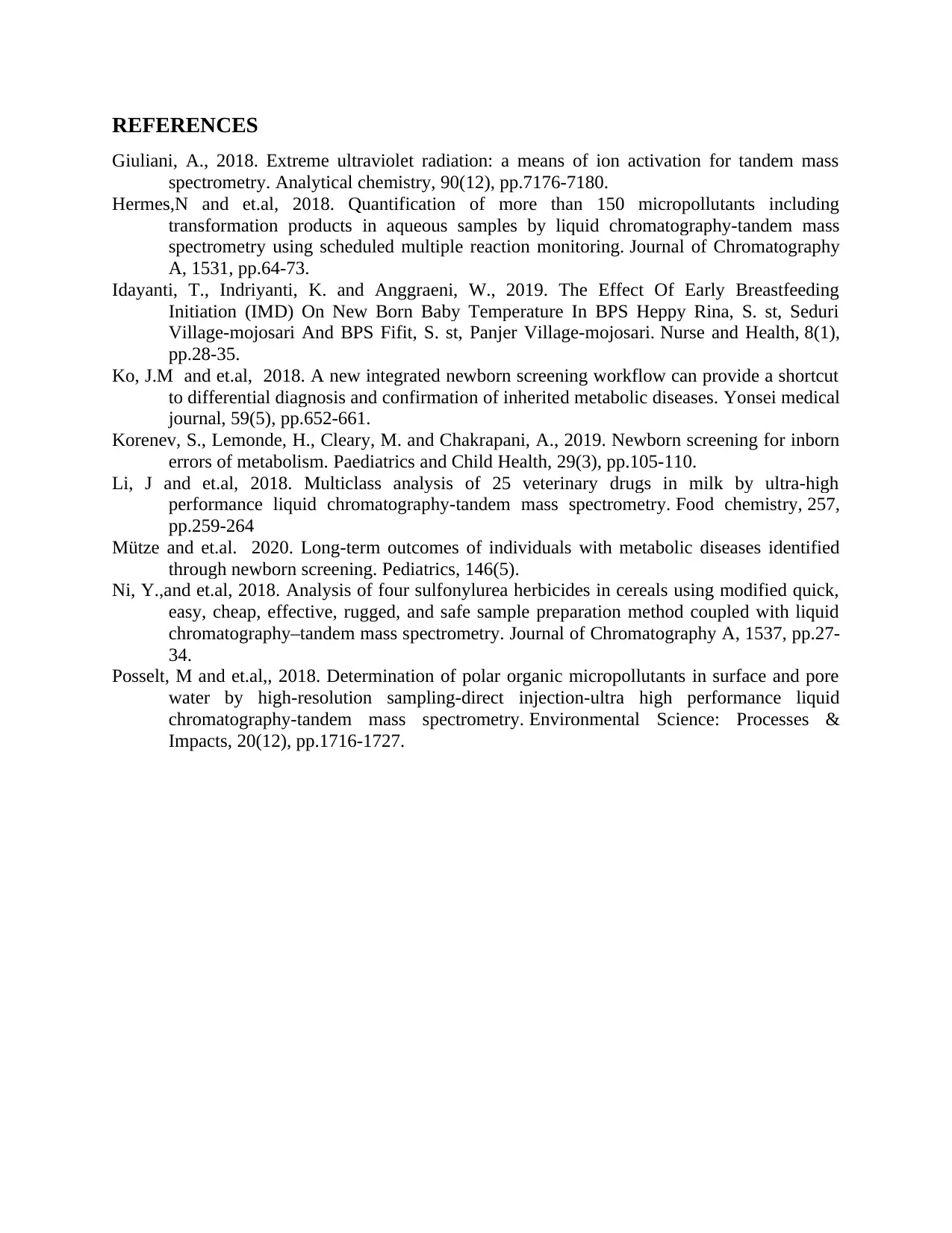
REFERENCES
Giuliani, A., 2018. Extreme ultraviolet radiation: a means of ion activation for tandem mass
spectrometry. Analytical chemistry, 90(12), pp.7176-7180.
Hermes,N and et.al, 2018. Quantification of more than 150 micropollutants including
transformation products in aqueous samples by liquid chromatography-tandem mass
spectrometry using scheduled multiple reaction monitoring. Journal of Chromatography
A, 1531, pp.64-73.
Idayanti, T., Indriyanti, K. and Anggraeni, W., 2019. The Effect Of Early Breastfeeding
Initiation (IMD) On New Born Baby Temperature In BPS Heppy Rina, S. st, Seduri
Village-mojosari And BPS Fifit, S. st, Panjer Village-mojosari. Nurse and Health, 8(1),
pp.28-35.
Ko, J.M and et.al, 2018. A new integrated newborn screening workflow can provide a shortcut
to differential diagnosis and confirmation of inherited metabolic diseases. Yonsei medical
journal, 59(5), pp.652-661.
Korenev, S., Lemonde, H., Cleary, M. and Chakrapani, A., 2019. Newborn screening for inborn
errors of metabolism. Paediatrics and Child Health, 29(3), pp.105-110.
Li, J and et.al, 2018. Multiclass analysis of 25 veterinary drugs in milk by ultra-high
performance liquid chromatography-tandem mass spectrometry. Food chemistry, 257,
pp.259-264
Mütze and et.al. 2020. Long-term outcomes of individuals with metabolic diseases identified
through newborn screening. Pediatrics, 146(5).
Ni, Y.,and et.al, 2018. Analysis of four sulfonylurea herbicides in cereals using modified quick,
easy, cheap, effective, rugged, and safe sample preparation method coupled with liquid
chromatography–tandem mass spectrometry. Journal of Chromatography A, 1537, pp.27-
34.
Posselt, M and et.al,, 2018. Determination of polar organic micropollutants in surface and pore
water by high-resolution sampling-direct injection-ultra high performance liquid
chromatography-tandem mass spectrometry. Environmental Science: Processes &
Impacts, 20(12), pp.1716-1727.
Giuliani, A., 2018. Extreme ultraviolet radiation: a means of ion activation for tandem mass
spectrometry. Analytical chemistry, 90(12), pp.7176-7180.
Hermes,N and et.al, 2018. Quantification of more than 150 micropollutants including
transformation products in aqueous samples by liquid chromatography-tandem mass
spectrometry using scheduled multiple reaction monitoring. Journal of Chromatography
A, 1531, pp.64-73.
Idayanti, T., Indriyanti, K. and Anggraeni, W., 2019. The Effect Of Early Breastfeeding
Initiation (IMD) On New Born Baby Temperature In BPS Heppy Rina, S. st, Seduri
Village-mojosari And BPS Fifit, S. st, Panjer Village-mojosari. Nurse and Health, 8(1),
pp.28-35.
Ko, J.M and et.al, 2018. A new integrated newborn screening workflow can provide a shortcut
to differential diagnosis and confirmation of inherited metabolic diseases. Yonsei medical
journal, 59(5), pp.652-661.
Korenev, S., Lemonde, H., Cleary, M. and Chakrapani, A., 2019. Newborn screening for inborn
errors of metabolism. Paediatrics and Child Health, 29(3), pp.105-110.
Li, J and et.al, 2018. Multiclass analysis of 25 veterinary drugs in milk by ultra-high
performance liquid chromatography-tandem mass spectrometry. Food chemistry, 257,
pp.259-264
Mütze and et.al. 2020. Long-term outcomes of individuals with metabolic diseases identified
through newborn screening. Pediatrics, 146(5).
Ni, Y.,and et.al, 2018. Analysis of four sulfonylurea herbicides in cereals using modified quick,
easy, cheap, effective, rugged, and safe sample preparation method coupled with liquid
chromatography–tandem mass spectrometry. Journal of Chromatography A, 1537, pp.27-
34.
Posselt, M and et.al,, 2018. Determination of polar organic micropollutants in surface and pore
water by high-resolution sampling-direct injection-ultra high performance liquid
chromatography-tandem mass spectrometry. Environmental Science: Processes &
Impacts, 20(12), pp.1716-1727.

⊘ This is a preview!⊘
Do you want full access?
Subscribe today to unlock all pages.

Trusted by 1+ million students worldwide
1 out of 12
Your All-in-One AI-Powered Toolkit for Academic Success.
+13062052269
info@desklib.com
Available 24*7 on WhatsApp / Email
![[object Object]](/_next/static/media/star-bottom.7253800d.svg)
Unlock your academic potential
Copyright © 2020–2025 A2Z Services. All Rights Reserved. Developed and managed by ZUCOL.